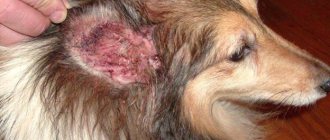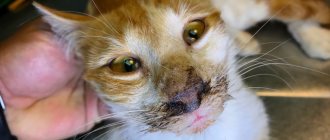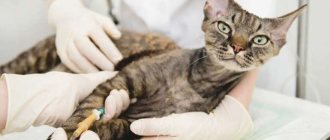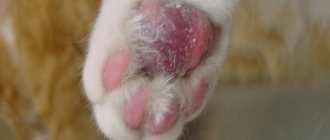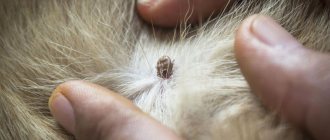What to do if atopic dermatitis appears in cats. Every person who has a furry animal at home thinks about its state of health, because only healthy animals can show the whole range of emotions, thereby delighting their owners. Do not forget that preventive measures that can be used even before the animal is attacked by any disease are sometimes more important than long-term and expensive treatment. Your animal must literally be groomed and cherished, but not all owners have enough time and energy for this. If you fall into the category of such owners, then the best alternative would be to seek help from veterinarians.
If you don’t have plenty of free time, then there is another option, such as calling a veterinarian at home; our veterinary center is happy to provide this service to its regular clients, as well as people who come to us for the first time. By seeking help in time, you can avoid a number of unpleasant consequences, especially since the health of the animal is always an important aspect.
Atopic dermatitis in cats
Today you can often hear that people refuse to get a cat because they are allergic to their fur or their parents are allergic. The topic is also constantly raised in one or another yellow publication, and also, without a doubt, on TV. But, one way or another, few people think about the fact that cats themselves can also be susceptible to ailments of skin origin, and suffer from them in the same way. And, especially when it comes to atopic dermatitis, even more so. It is atopy in a cat that is one of those ailments that veterinarians most often have to diagnose in an animal. The point here is that this disease is not very different at first glance from the manifestations and symptoms of allergic dermatitis.
Therefore, an important factor here is that the veterinarian can talk with you, as with the owner of the animal, in order to be able to clarify everything as much as possible. In the same way, the correct and clear diagnosis will directly depend on this conversation and the experience of the veterinarian, which in turn will help prescribe treatment and bring the animal out of a state of painful crisis as quickly as possible. And, although visually one might think that the causes of the disease are hidden on the surface, that is, on the cat’s skin itself, in fact it turns out that all the reasons are inside the animal’s body, which is why helping a pet overcome the disease is not as easy and quick as we would like .
For what reason is this dermatitis in cats called “atopic”?
Let's look into this issue too. The disease got its name from a word like “atopy,” which means the extent to which the animal’s body is able to synthesize immunoglobulin E (special antibodies to various allergens). Thus, having formed once during the first contact with the “culprit” substance - the provocateur, they remain in the internal environment for almost the entire life. Subsequently, if repeated contact with the allergen occurs, they resonate with a response. The big disadvantage here is that this factor can be inherited. However, this does not always mean the strict fact that if atopic dermatitis in cats is present in older animals, then it will manifest itself in younger animals; the disease may not at all appear.
Symptoms and signs
Symptoms of atopic dermatitis begin to appear at any age. But most of the observed patients in the practice of veterinary dermatologists are less than 1 year old. They are sensitive to various drugs. There may be diseases that mimic atopy, such as ectoparasites , which must first be excluded before making a diagnosis of atopy.
Differentiating problems include: food allergies, dermatophytosis, demodicosis, Malassezia dermatitis, pemphigus foliaceus and bacterial pyoderma. You will find the entire list in a larger and more detailed article about atopic dermatitis in cats.
A good history is required to diagnose veterinary dermatology cases. Before diagnosing atopy, take a detailed medical history.
For example:
- Age at which skin problems begin
- Where do you spend your time most often - indoors or outdoors?
- Presence of other pets in the house.
- Are there other people with skin problems?
- Does a cat react to hormones?
- Seasonality of symptoms
Clinical signs of atopic dermatitis vary widely:
- Itching: on the face (varies from hair loss on the ears to severe facial irritation involving the eyes, preauricular areas, commissures of the mouth or chin), rectal, trunk,
- Otitis media is waxy with or without infection. It can be constant, weak due to infection with recurrent fungal otitis. Bacterial otitis also occurs, but not as often as waxy and fungal otitis.
- Eosinophilic granuloma
- Complex lesions
- Alopecia of the hock joints
- Acne on the chin
- Combs
Reasons why atopic dermatitis occurs in cats
It is worth saying that today veterinary doctors consider this animal skin disease to be a genetically determined factor , which can only occur in those animals that are more predisposed to it and are more open. Atopic dermatitis in a cat is an inflammation of the skin of an animal that occurs against the background of a generalized allergic reaction.
What are the clinical manifestations of the disease, atopic dermatitis in cats symptoms
And, as for the clinical picture itself, it is quite blurry. Moreover, it is not very specific. At this point in time, veterinary doctors are adding up disappointing statistics from the fact that more and more animals are being exposed to this disease.
Among the main reasons that provoke this type of dermatitis are:
- Deterioration of the environmental situation.
- Too many harmful additives have been added to food.
- Incorrect and unbalanced nutrition of a pregnant cat.
- The influence of sex hormones on the physical health of the animal itself and on their provocation of the course of the disease.
- Some researchers seriously believe that the illness in some cats may be associated with a disease such as bronchitis or bronchial asthma. However, so far, exactly how exactly these two different diseases are related to each other has not been studied.
At the very beginning of the manifestation of the disease, the cat may simply gnaw or even chew its limbs. This point may not be noticed, because such “attacks” rarely occur in an animal, but over time they usually become more frequent. As a result, the animal actually causes suffering to itself: because it gnaws its skin, almost until it bleeds. Similar manifestations or “attacks” are divided into:
- seasonal;
- not seasonal.
When you see that your animal begins to gnaw its skin in the summer, this is due to an allergy to the same pollen, in this case your animal, at least in theory, but you can identify the allergen, and later isolate the pet from the provoking factor . When an animal does this throughout the whole year, regardless of the change of season outside the window, the reason for this may be food, or an allergy to fleas, which bite him very much, and by biting his skin, he seems to reduce his pain, although and immediately creates another one.
Causes of the disease
It is worth noting that a person can also develop atopic dermatitis. The first and main cause of this disease is the genetic predisposition of certain breeds of cats. As a rule, manifestations begin at 8-9 months of the animal’s life.
Every year the number of cats suffering from allergies increases. A pregnant cat, consuming low-quality food, suddenly becomes allergic to something. Already in the womb she will transmit this disease to her kittens.
In some cats, manifestations of atopic dermatitis begin during puberty. Therefore, scientists suggest that sex hormones also somehow influence the development of the disease.
© shutterstock
The great predisposition of cats to bronchial asthma and bronchitis often causes allergic skin reactions.
This disease has not yet been fully studied, so you need to be attentive to your pet.
What other causes of atopy in cats could be?
The epithelium of a cat can react quite sensitively even to the same dust mites found in the apartment, or rather, to the products of their vital activity. Household chemicals themselves are an excellent provocateur of skin problems (atopy in cats) in animals sensitive to them.
Testing and treatment
So, the first stage will be the exclusion and treatment of ectoparasites, carrying out a hypoallergenic diet for 6-8 weeks. If you then suspect that your cat needs to be treated for atopic dermatitis, you should move on to the next step. A positive point during testing will be if it is a male, neutered with a tabby color (tabby) and with shedding (baldness) on the hocks.
The next step is treatment, including steroids (if used short-term), antihistamines, immunotherapy or cyclosporine. They can be used until the desired effect of immunotherapy occurs. Of course, if immunotherapy is chosen, a skin or serum allergy test is performed to determine which antigens need to be put into the solution.
In my experience, cats do very well with immunotherapy, and in many cases the subcutaneous injection is easier to administer than giving pills. The main disadvantage is the response time to therapy because immunotherapy takes many months to become effective.
If you are testing serum using the Heska test, ensure that the positive results correspond to the time of year when symptoms are observed. Also, hormones and antihistamines interfere with serum analysis. So avoid them for as long as possible before testing. There is no specific downtime because each individual animal differs in its sensitivity. Some of them are checked a month after cancellation. While others require several months without steroids to get accurate results. Cats given megestrol acetate seem to take longer to come off the drug before the first positive test.
Fall is the best season to test because the animal has just been exposed to spring, summer and fall pollen and year-round dust mites. The latter often flares up when the heating is on, daylight hours become shorter, because... they prefer darkness.
Once immunotherapy is started, the owner should be advised that if the cat appears more itchy, they should stop the injections and call you. This usually means the dose was too high and you are causing itching. Some cats are itchy after the first dose and require dilution from the start.
If antihistamines, hormones or cyclosporine are chosen as the treatment method, it is not necessary to know which allergens the allergy occurs to. Sometimes we start with chlorpheniramine 4 mg, ½-liter tablet (2 times a day) or clemastine 1.34 mg (2 times a day), ½ tablet.
A small percentage will only respond to antihistamines, which is great because... you avoid steroids. Their main disadvantage is their bitter taste. Excessive salivation often occurs, which is frightening for some owners. Antihistamine tolerance can occur over time. To avoid this, give these drugs daily for three weeks to one month. Then one week and then resume taking it. They should be used with caution in keratoconjunctivitis, pregnant animals, glaucoma, heart disease, megacolon, and seizure disorders.
At what age can atopic dermatitis be diagnosed in cats?
Often, atopic dermatitis can be first diagnosed between the ages of one and three years. The animal exhibits alopecia, but only focally. Most often, when an animal gets sick, the following areas are affected:
- armpits;
- belly;
- genitals.
That is, those areas where the skin is already the thinnest and most delicate. To be able to establish the exact cause of the disease, you will need an accurate and detailed medical history from a veterinarian, information about the animal’s pedigree, as well as information about its quality and nutrition schedule. After which it is necessary to take tests such as :
- blood;
- urine;
- feces;
- It is necessary to scrape the skin;
- allergy tests are carried out, since their result can give a faster answer to the current situation, but most importantly, the result of the resulting analysis will answer the question: “What exactly substance contributed to the start of the chain reaction and resulted in relapses of the disease?”; However, the stumbling block in carrying out the analysis may be the price, because the procedure is quite expensive and not all animal owners have the opportunity to carry it out.
You can get all the necessary tests for your animal at the Ya-Vet veterinary clinic. We perform tests in certified laboratories and send the results by email within 24 hours. Or we do express tests at your home without additional stress for your pet and tell you the result in 15 minutes. For more details, please contact us by calling the numbers provided. Telephone consultation is free.
Intradermal allergy tests
Methodology Intradermal allergy testing is considered the most accurate of all sampling methods available, but it requires considerable experience to interpret the results. Allergens lose their potency over time, which is why new sampling kits need to be released regularly and old ones scrapped; Consequently, the financial practicality of this technique will depend on the number of patients a doctor has, and often these studies are carried out on a referral basis. An initial sampling kit is created every 4-6 weeks and stored in sterile glass allergen bottles. New syringes are removed from these vials every week and any unused allergens are discarded. In cats, one must additionally keep in mind the possibility of transmission of the feline immunodeficiency virus; For each animal you need to take new needles.
Intradermal injections in cats are technically more complex than in dogs and horses due to the thin skin of these animal species. To minimize the increase in cortisol levels in response to manipulation, the cat must be sedated. A combination of ketamine (5 mg/kg) and diazepam (0.25 mg/kg) intravenously or tiletamine-zolazepam (Telazol, A.N. Robbins, Richmond, W) (4 mg/kg) intravenously works well. The lateral chest is shaved with a #40 blade and the injection sites are marked with a waterproof marker. Then 0.05-0.1 ml of each allergen, a positive (histamine) and a negative control allergen (an allergen-solvent that contains 0.4% phenol) are injected intradermally.
The following factors are used to evaluate the response to specific allergens: the degree of erythema, swelling, induration or induration, the diameter of the blister, and the appearance of the cocoon-like projection at the affected area. Blisters are examined by palpation and visually. Erythema can usually be observed only on non-pigmented skin. A subjective comparison is made between negative and positive control data. All positive control results are scored as 4+, negative ones as O, and the remaining results are scored subjectively in comparison with the specified numbers.
The author first took skin test readings in cats in a darkened room, since the boundaries and height of the blisters are easier to observe with side lighting from a point light source. Skin test reactions in cats were assessed within 10-15 minutes after injections. This method requires experience and should be carried out under the guidance of a qualified professional. If the intradermal allergen extract is improperly diluted, false-positive or “irritant” reactions may occur. A study was carried out in cats on the amount of allergen at which it did not cause an “irritant” reaction (Bevier; 1990) and similarly it was used in dogs. The injection study used in humans has not been studied in cats. Some authors have proposed using a fixed lesion diameter to evaluate positive and negative controls, and allergen companies have developed "reactive probes" with circles adjacent to clear plastic "rulers" to allow easy assessment of lesion diameter. Thanks to this, it is possible to measure histamine-positive control data as only 1+ or 2+.
Interpreting Positive Test Results Accurate knowledge of the important allergens and (in the case of pollen allergens) the timing of pollination of specific plants in the cat's geographic area is essential to the interpretation of test results. Allergy laboratories, dermatologists (preferably veterinary dermatologists), local government departments, and plant nurseries can be contacted to obtain this information. Books describing regional plants and local grasses and trees are commercially available, but they are usually intended for botanists, so they do not only cover plants that cause allergic diseases.
When interpreting the results, the author considers positive reactions to known environmental allergens and all seasonal reactions noted in the medical history. If skin test reactions do not correspond to clinical and medical history data, one needs to think about the “allergic threshold” (this is the elusive level above which signs of allergy appear and below which the animal does not show clinical signs; for example, a domestic cat may be allergic to dust particles). mites and pollen, but she has no symptoms in winter). It is possible that this cat has previously been exposed to some allergens that caused a positive reaction that is not consistent with the present medical history. To interpret positive test results, you need to carefully study your medical history and know possible allergens.
Atopic dermatitis in cats - treatment
Typically, the treatment of atopic dermatitis in a cat consists of the veterinarian prescribing drug therapy consisting of broad-spectrum antibiotics and/or other antimicrobial drugs. Another point of treatment will be to stop the manifestation of an allergic reaction in the animal as quickly as possible. Then conventional antihistamines are prescribed, such as:
- clemastine;
- Diphenhydramine
A diet is also prescribed that excludes any allergens from the animal’s diet. And, of course, in almost all cases non-steroidal anti-inflammatory drugs are prescribed. An important role in the recovery process of a pet is played by the care and attention coming from its owner. Our veterinary center treats atopic dermatitis in cats and is open to helping your pet.
Nutritional Features
When symptoms of atopy appear, the animal needs a special diet. You need to follow it for at least 2 months, after which you can carefully switch to the usual diet (if the cat eats natural food). Veterinarians advise switching the animal to rice and rabbit if its protein does not cause a negative reaction. Additionally, the pet should receive omega-3 polyunsaturated fatty acids and biotin.
On such a diet without treatment, symptoms will subside after 2-3 months. If it is supported by drug therapy, the cat gets better much faster. For animals that prefer ready-made food, a hypoallergenic holistic food is selected. With the consent of the doctor, you should give your cat fish oil, cleansing tea, and vitamins (for example, Vittri).
Animal care and prevention
During illness, you need to ensure that your pet always has fresh boiled water in his bowl. It is advisable to arrange a cozy and quiet place for the cat where she can rest. For these purposes, it is recommended to purchase a special bedding. If an animal wants privacy and avoids contact, then you should not interrupt its rest, pet it or pick it up.
During illness, it is not recommended to comb the fur, as the skin can be damaged even more.
If possible, you should open the window so that your pet can breathe fresh air. However, hypothermia should not be allowed. Enough ventilation. It is not recommended to bathe your cat during treatment for dermatitis. Particular attention should be paid to the area of localization of inflammation. It is important to ensure that your pet does not scratch its skin. For this purpose, it is not recommended to remove the blanket until complete recovery.
During the recovery period, the cat needs peace and quiet.
How to prevent the occurrence of the disease:
- Feed your pet only specialized food, avoiding low-quality options.
- Balance your pet’s diet so that the menu includes not only dry food, but also other healthy foods.
- Bathe the animal once every 4–6 months, provided that the cat does not go outside. Otherwise, this should be done more often.
- Worm the cat once a quarter.
- Do not give your pet medications unless prescribed by a veterinarian.
- Buy an anti-flea collar and put it on your cat. This is especially important if the animal is often outside.
- Give your four-legged friend vitamins, as well as special grass rich in healthy fiber.
Grass for cats is a source of fiber that strengthens the immune system.
To prevent the occurrence of dermatitis, many veterinarians recommend regularly examining the animal's skin to identify the first symptoms of the disease. Vaccination should also not be neglected.
